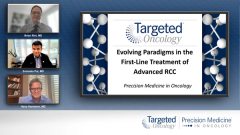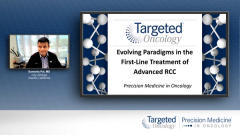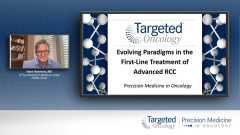
Overview of the Treatment Landscape in Advanced Clear Cell RCC
Expert hematologist/oncologist Brian Rini, MD, spearheads a comprehensive discussion on the broad treatment landscape for advanced clear cell renal cell carcinoma.
Episodes in this series

Transcript:
Brian Rini, MD: Thanks for joining “Evidence-Based Strategies for Selecting Appropriate Frontline Therapy in Advanced RCC.” I’m Brian Rini, a professor of medicine in the division of hematology-oncology at Vanderbilt University Medical Center and also the chief of clinical trials at Vanderbilt-Ingram Cancer Center [in Nashville, Tennessee]. Joining me are 2 esteemed colleagues, Dr Monty Pal and Dr Hans Hammers. I’d like to invite them to introduce themselves. Dr Pal, you can go first.
Sumanta Pal, MD, FASCO: Hi, my name is Monty. I’m a medical oncologist at City of Hope [in Duarte, California] focused on GU [genitourinary] cancers.
Hans Hammers, MD, PhD: Hi, I’m Hans Hammers. I’m a GU medical oncologist focused on kidney cancers at UT [University of Texas] Southwestern [Medical Center] in Dallas [Texas].
Brian Rini, MD: Great, thank you both for joining me. We’re going to discuss recent advances in the treatment of advanced kidney cancer and the impact of the data on clinical practice. Drs Pal and Hammers will discuss their approaches to selecting frontline therapies focusing on specific regimens, and then we’ll dive into some of the clinical implications of the data and how we treat patients in clinical practice. Let’s start with our first topic. I’ll give a summary of frontline kidney cancer, which has evolved over the last several years from an era when we were giving single-agent tyrosine kinase inhibitors [TKIs] to immune-based doublets in the frontline setting. I’ll walk briefly through the data. I may ask Monty or Hans to comment on some of the big-picture data, and then I’m going to turn it over to them to comment on other specific regimens.
This slide is a summary of the latest data of the 4 recent trials in kidney cancer that have shown a survival advantage. There have been 6 trials in the last 5 years or so in frontline clear cell kidney cancer using immune-based doublets. Four of them have shown an overall survival advantage; those are shown in the 4 columns here. On the far left is ipilimumab-nivolumab, which are the most mature data and the only immune-immune doublet of the 4. Then from left to right are 3 I/O [immuno-oncology]–TKI doublets: axitinib-pembrolizumab, cabozantinib-nivolumab, and lenvatinib-pembrolizumab, in the order they were presented. There are a lot of data on this slide. I’m going to make some high-level points and then invite Hans and Monty to comment if they want to fill in anything.
When I look at these data, I see some trends. I see a pretty consistent overall survival [OS] benefit vs sunitinib monotherapy, which was the control arm in all these trials. Hazard ratios have moved around over time, but they’ve all settled in with about 3 to 5 years of follow-up in the 0.7 range. Despite differences in the components in the specific TKI on patient populations, we have a pretty consistent overall survival benefit. It’s pretty clear that when your doublet includes a VEGF TKI, you get more tumor shrinkage. You get higher response rates, of 60% to 70%. You get lower hazard ratios, all the way down to 0.39 with lenvatinib-pembrolizumab, and a pretty consistent complete response rate, in the 10%-to-12% range.
Consistent with that tumor shrinkage or disease control that TKIs provide, you get less progression as best response with the I/O–TKI regimens in the range of 5% to 10% compared with almost 20% with ipilimumab-nivolumab. However, CTLA4-containing regimens perhaps have a higher tail of the curve. I say perhaps because we don’t have as much follow-up on the I/O–TKI regimens as we need. If there’s going to be a tail of the curve, [we need to know] what that tail might be. We have a minimum 5-year follow-up with ipilimumab-nivolumab. That landmark PFS [progression-free survival] of 30% progression-free [survival] of 5 years is the high-water mark in kidney cancer. We’ll see how the I/O–TKI data sets mature, but that’s a calling card of immune-based regimens, especially a dual immune-based regimen. You’re going to have that durability in a significant subset of patients.
This is a similar slide with the same 4 trials, but I’ve added a couple of monotherapy trials—including 1 with nivolumab and 1 with pembrolizumab—in IMDC [International Metastatic Renal Cell Carcinoma Database Consortium] favorable risk. I put this slide together because there’s a lot of discussion about this subset, which represented 20% to 30% of patients in the frontline trials, as I presented on the previous slide. What to do in this subset? There are a lot of data on the slide, but let me give you my take-home messages. They are actually more inconsistent overall survival effects. Remember, these are small subsets, so instead of 800 to 1000 patients, you’re looking at subsets that are approximately 100 patients, plus or minus. Some of that inconsistency may result from that. You’re not consistently seeing hazard ratios in that 0.7 range; they’re all hovering around 1. With the I/O–TKI regimens, you still see enhanced tumor shrinkage end points, response rates, etc.
Favorable risk is known to be more angiogenic driven, so you get longer PFS and higher response rates. A subset of favorable-risk kidney cancer is clearly immune responsive, and I’m focused on the ipilimumab-nivolumab data, when we see response rates of 30% and a CR [complete response] rate of 13%. Despite what I said about favorable risk being mostly angiogenic driven, it’s clearly not entirely angiogenic driven. There’s a significant subset of patients who are immune responsive. We don’t know how to identify those patients, but to me the data are pretty clear.
The monotherapy data are very inconsistent. We’re comparing subsets of 35 vs 42 patients, so perhaps it’s not surprising that some of those numbers are all over the map. The initial pembrolizumab data from KEYNOTE-427 are presented on the far right, and the ACR [American College of Radiology] end data are presented more recently with nivolumab monotherapy for a robust response rate of nearly 60% in that subset. These small numbers may point to our lack of biomarkers and being able to select those patients. That was a ton of data. I’ll pause and ask Hans and Monty to comment if there’s anything major I missed. Hans, do you disagree with anything I said? Do you want to add anything?
Hans Hammers, MD, PhD: No, this was perfect, Brian. With CheckMate 214, nivolumab-ipilimumab, 1 salient feature is this platform that we see. These are durable responses that tend to be longer than the responses we see with the TKI–PD-1 combinations, meaning the quality of responses is different. But I agree: 1 of the main problems with nivolumab-ipilimumab is progressive disease as best response. It’s 1 of the weaknesses of this regimen that you don’t see with PD-1–TKI combinations. In patients for whom response and disease control is everything, the standard would be to consider a combination of a PD-1 inhibitor with a VEGF agent.
Brian Rini, MD: Thanks. Monty, anything to add?
Sumanta Pal, MD, FASCO: No, this was well done, Brian. I encourage everybody watching to search for these tables online through Google or Twitter. You did a brilliant job of updating these continually. It helps folks like me, even though I’m immersed in the field, contextualize what’s going on. I find it really helpful.
Brian Rini, MD: Thanks, Monty. I appreciate it. I’m going to briefly touch on some individual trials before I turn it over to these guys to talk in a little more detail about the 2 most recent I/O–TKI trials. This is CheckMate 214, ipilimumab-nivolumab, and some of the medians for overall survival. These medians are fairly mature, but the I/O–TKI medians aren’t as mature. There’s more censoring, but these are fairly mature with a minimum 5 years of follow-up.
If you look at that ITT [intent to treat] column, you see is a median survival of 55.7 months for ipilimumab-nivolumab. That’s really impressive. That’s a high-water mark. It’s the highest median we’ve ever seen in this disease. It’s a number I use with patients when I’m counseling them on day 1. Patients always want to know, “What’s my expected survival? How long am I going to live?” I use that number to provide hope: on average, patients with kidney cancer are living nearly 5 years, and a subset of them are cured. We don’t know exactly what that subset number is, but I believe more than a few patients who are cured. You see differences, as you look in the intermediate poor vs favorable risk. Favorable risk is favorable for a reason. [These patients] have more indolent disease, so it’s not surprising that those medians are much longer.
I have a couple of slides about the role of ipilimumab in metastatic kidney cancer. This is just my opinion based on the data. It’s pretty clear if you’re going to use this agent, nivolumab-ipilimumab, then you need to give it early. There aren’t great data with ipilimumab as a salvage agent. There are a couple of trials—we’re not going to detail them—started with nivolumab and tried to add it to ipilimumab only if patients progressed or failed to respond by a certain time point. Those trials largely failed. They didn’t salvage many patients. It didn’t result in complete responses, which is certainly 1 goal of this regimen. The tolerance was probably not as good in a refractory setting. But if you look at the early ipilimumab data in CheckMate 214, which we’ve been talking about, you see a higher PFS tail of the curve. Also, patients who can be off treatment with controlled disease—the so-called disease-free interval, which many have looked at—you see a higher CR rating combination compared with, say, nivolumab monotherapy. There are a number of clinical features, and we can argue I/O–I/O vs I/O–TKI. I have a summary slide at the end, but if you’re going to give this agent, you need to do it early in the course of this disease.
Let’s turn to CheckMate 9ER for cabozantinib-nivolumab. These are some of the numbers, and this was present on the other table. You see about a doubling of the progression-free survival and a corresponding hazard ratio. I’ll caution that these median OS numbers are fairly immature because of the length of the follow-ups. These numbers are going to go up over time.
This is the PFS for CLEAR, or the lenvatinib-pembrolizumab combination. It’s the most impressive from an absolute numbers standpoint. There was a median progression-free survival of nearly 2 years with this combination and a very low hazard ratio. It’s the most impressive tumor-shrinking regimen that we’ve seen. We’re comparing across trials, but they’re relatively contemporaneous trials in populations that were fairly similar. These results look the most robust. I’ll ask both of you to comment, when you get to your sections, on how you interpret these data.
There was also a lenvatinib-everolimus arm in this trial for regulatory reasons. It’s slotted in the middle. People generally ignore this arm. I don’t think it contributed much to understanding that particular combination, which is still more often used in a salvage setting.
These are the overall survival data. This was the most recently completed and reported trial, and that’s why all the medians haven’t been reached. That hazard ratio has been updated to 0.7, as I alluded to before. We need to follow these trials longer term to look at things like durability response and obviously some of the median survival numbers.
This is a slide that I put together. This is something we’ve been debating for years in kidney cancer. It’s probably time to move beyond this argument, but it still comes up in practice: are you going to get patients with ipilimumab-nivolumab as their first treatment or 1 of the I/O–TKI regimens? I won’t read this to you, but there are a lot of reasons to choose [1 over the other]. Hans alluded to the disease-controlling aspect of the I/O–TKI regimens for patients, in which early progression could have clinical consequences: symptomatic disease, bulky disease, disease in bad spots, etc. That’s a generally accepted principle. Not shown here, there are some really interesting data about use of ipilimumab-nivolumab on sarcomatoid histology patients with fantastic responses. Many use that as a biomarker to select that regimen. There are pros and cons on both sides, and each practitioner settled into their own pattern, none of which is right or wrong. We all agree that understanding a regimen well—drugs, how to dose, when to hold, how to treat adverse effects—is probably more critical than arguing 1 regimen vs another.
I’ll summarize this first part by saying that kidney cancer is predominantly angiogenic and inflammatory. That’s why all the drugs we have are directed against those pathways. I/O–based doublets are the standard of care, whether that anti–PD-1 agent is combined with a VEGF agent or ipilimumab. There are pluses and minuses in different data. I don’t think using a single-agent TKI is any longer a standard of care, barring patients who can’t get immunotherapy. A single-agent TKI does not cure patients, but an immune-based regimen can. Comfort with a particular regimen is critical. Whatever regimen you’re going to choose, make sure you understand it and the nuances of it, and that your staff does as well, including other providers. That goes a long way in taking care of patients.
Transcript edited for clarity.












































